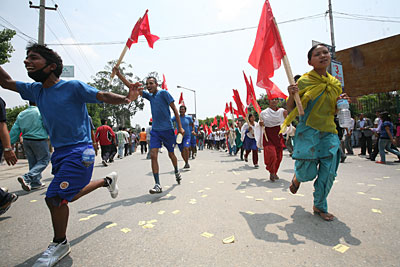From Nepali Times, ISSUE #501 (07 MAY 2010 – 13 MAY 2010)
To give in to the Maoist strike is to fundamentally undermine Nepali democracy
Certain home truths have to be brought before Kathmandu’s waffling commentator brigade, which wants to have it both ways in analysing the indefinite Maoist general strike. The analysts sit on the fence while the mass public suffers because one man seeks an extra-constitutional path back to prime ministership.

If one accepts the basics of pluralism and non-violence as the guiding principles of our society, it is very easy to come to the conclusion that this general strike is a travesty. Announced by the Maoists as a ‘revolt’ to bring down the government, it is also against the constitution.
As for whether this aam hadtal is peaceful, the commentators and the international community would do well to consider the matter of ‘structural violence’. Nepal is the 40th largest country in the world by population and the volume of pain that is being foisted on a beleaguered public is therefore gigantic. Only those taken in by Maoist rhetoric would pull back from demanding an unconditional lifting of the general strike.
Those who would tie the resignation of Madhav Kumar Nepal to the lifting of the strike are asking us to succumb to political blackmail. The UCPN (Maoist) negotiated and signed the Interim Constitution, under which the former rebels participated in elections and joined government, which they then left foolishly amidst internal bickering (ref. the ‘commander-in-chief episode’). Thereafter, 22 parties out of 24 in the House came together to set up the present government through parliamentary process.
For a year now, the Maoist leaders have dragged the public through a campaign of ‘civilian supremacy’ under false pretences, one which included denigration of the republic’s first president, five months of parliamentary closure, Singha Darbar encirclement, and a short-lived anti-India campaign. For a while, the leaders did contemplate a no-confidence motion, the only time they acted democratically this past year.
There can be two legitimate ways for the Maoists to enter (and even lead) government: get 301 on their side for a majority coalition, or build trust with the other parties for a national unity government. The latter is advisable, because there is a constitution to be written and the Maoists are the largest party in the CA. However, extra-constitutional tactics will not lead to a democratic constitution, which would mean decades of conflict up ahead and a drag on economic growth and social transformation.
The Nepal government is weak, but the way to topple even a middling government is through constitutional process, be it in London, Paris or Kathmandu. Changing a government through street blackmail will lead to endless instability, and the anarchy of the recent past will pale in comparison. If the precedent is accepted as so many otherwise thoughtful people would suggest, there is no saying where we will end up. There are enough fundamentalist, opportunistic forces out there waiting for the road to be cleared.
Those who believe the parliamentary parties to be craven must study how they stack up against political parties elsewhere in Southasia and the West. And they would not come up short at all, not the Nepali Congress, CPN (UML), NPWP, RPP or the Madhes-centric parties. While we have to see how the political spectrum transforms in the years ahead, there is no other path for the UCPN (Maoist) to take than towards the social-democratic middle of Nepali politics. It is clear by now that they have no magic wand for transformation, as promised from loudspeakers in the jungle.
Only those who believe that a socialist utopia is possible in Nepal (and nowhere else, interestingly) would buy Baburam Bhattarai’s argument that the Maoists have new wares. The romance of the revolutionary promise has waned somewhat on the ground by now, and the people await the Maoist transformation into a civilian party in word and deed (including a formal declaration of their abandonment of violence and the disbandment of the cantonments).
As far as the cantonments are concerned, the prevarication in the peace process comes almost entirely from the UCPN (Maoist). It thus has not lived up to the promise made to the people under the 12 Point Agreement that it would transform into a civilian party. It has held on to the cantonments instead of transferring control to the Special Committee, which has representation of the major political parties. If there is one element that will guarantee the simultaneous failure of constitution-drafting and the peace process, it is this.
Having recklessly promised the former combatants ‘full integration’ into the national army, Pushpa Kamal Dahal finds himself cornered. Seeing competition for leadership within his own party, the chairman has decided to secure his position by using the ultra-nationalist card that brings the radicals to his side. Not having the courage to confront the cadre, devastating logic leads him to the present brinkmanship of street action. The only way to remain at the helm is to emerge as the party’s sole contender for the prime ministership.
Something good may still come out of all this. The marathon meetings that have been held in the last week amidst the chaos have actually led to a narrowing of differences between the Maoists and the rest. Ideally, what we need now is relentless negotiation in the following three areas:
1. Constitutional process (extending the CA deadline and adopting directive principles to guide constitution drafting)
2. Peace process (setting the number for integration and defining the transfer of the cantonment command to the Special Committee)
3. Formation of a national unity government.
Before any of this can begin, however, the Maoists must call off the general strike.